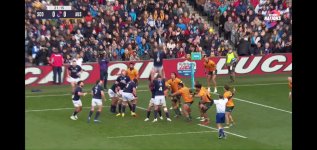belladonna
Rugby Expert
- Joined
- Nov 14, 2018
- Messages
- 448
- Post Likes
- 118
- Current Referee grade:
- Select Grade
Thank you Jarrod, you said it for me.


View attachment 4268
A still showing the position of blue 7 as the ball is being received by the jumper.
After re-readng law 18, I was left with a question - hasn't blue 7 illegally left the lineout?
- He must be in the straight line of players unless swapping with another lineout player, which he clearly isn't.
- He can peel off the lineout if he keeps moving, but he's stopped.
- And he can't move to the receiver position because it's already occupied.
To my reading, law 18.38 implies that leaving the lineout means leaving the single line of players, otherwise it would be meaningless.
[LAWS]18.10 Each team forms a single line parallel to and half a metre from the mark of touch on their side of the lineout between the five-metre and 15-metre lines.
[/LAWS]
[LAWS]18.17a Once the lineout is formed, players from the team throwing in may not leave the lineout other than to change positions with other participating players.
[/LAWS]
[LAWS]18.29d Once the lineout has commenced, any player in the lineout may leave the lineout so as to be in a position to receive the ball, provided they remain within 10 metres of the mark of touch and they keep moving until the lineout is over.
[/LAWS]
[LAWS]18.38 Other than by moving to the receiver position if that position is empty, no lineout player may leave the lineout until it has ended.[/LAWS]
He's in a position to receive the ball, though. Does he clearly and obviously stop moving?
He's in a position to receive the ball, though. Does he clearly and obviously stop moving?

For me it’s just good old fashioned obstruction / offside , ball carrier ran forward into his own players, no different to when lifters step in front of the receiver when they lower him and start to set a maul, they are in front of the ball carrier so no dice. Penalty gold
Didds, I think the reason the FW is regarded as dangerous at a PK/FK is in part because the wedge can get up some momentum before the opposition can try and stop it as they ahve to beack 10m (or less if near the goal line) The situation with a driving maul is almost always a similar layout to a FW, the difference being that they are already engaged with the opposition.
Didds, I think the reason the FW is regarded as dangerous at a PK/FK is in part because the wedge can get up some momentum before the opposition can try and stop it as they ahve to beack 10m (or less if near the goal line) The situation with a driving maul is almost always a similar layout to a FW, the difference being that they are already engaged with the opposition.


Its still a flying wedge - aside from the belief apparently amongst the lawmakers that it can only ever happen at a FK/PK apparently - presumably becasue only then is it dangerous for sopme bizarre reason
I appreciate I am in a minority of one here.
The law does not say anything about intention. You are choosing to infer it .well I agree, because that's exactly what I am saying: to be legal you have to have a realistic intention / plan / opportunity of receiving the ball.
You must be leaving the line out SO AS to [..] receive the ball. (not to catch the oppo into an offence, or to push better at the maul)
So IMO #7 in the example wasn't legal as he had no intention or possibility of receiving the ball .
You are reluctant to say whether you think #7 was legal or not? whaddya think ?
sigh, ob- another one for you to look up!The law does not say anything about intention. You are choosing to infer it .
.
